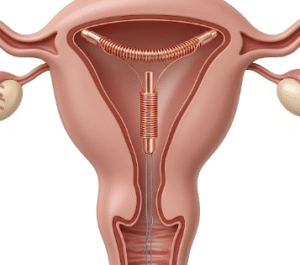Overview
Bleeding after menopause, also called postmenopausal bleeding (PMB), refers to any vaginal bleeding occurring after a woman has gone through menopause, typically defined as 12 consecutive months without menstruation. Although sometimes benign, PMB can be a sign of serious underlying conditions, including uterine or endometrial cancer, atrophic changes, or hormonal imbalances.
In Korea, postmenopausal women have access to advanced gynecological care, diagnostic imaging, and minimally invasive treatment options. Early evaluation of PMB is critical to identify and manage potential causes and to maintain overall reproductive and systemic health.
What is Bleeding After Menopause?
Bleeding after menopause occurs when the uterine lining (endometrium) or other parts of the reproductive tract experience disruption or abnormal growth, leading to bleeding. PMB can be:
- Spotting or light bleeding: Minimal blood loss that may occur intermittently
- Moderate to heavy bleeding: Larger amounts that may indicate structural or malignant causes
Even a small amount of blood after menopause warrants medical evaluation in Korea, as timely diagnosis can detect precancerous or cancerous lesions early.
Symptoms
Symptoms associated with postmenopausal bleeding include:
- Vaginal bleeding or spotting: Blood may be bright red, brown, or mixed with discharge
- Pelvic or abdominal pain: May accompany structural abnormalities
- Unusual vaginal discharge
- Urinary or bowel symptoms: If masses compress surrounding organs
- Fatigue or anemia: In cases of heavier, prolonged bleeding
Because PMB can be subtle, many women may not recognize it immediately, making routine check-ups essential.
Causes
Bleeding after menopause can result from several conditions:
Benign causes:
- Endometrial atrophy: Thinning of the uterine lining due to low estrogen
- Endometrial polyps: Noncancerous growths in the uterus
- Hormone replacement therapy (HRT): Estrogen or progesterone imbalance
- Vaginal or cervical trauma: Infection, sexual activity, or instrumentation
Malignant or precancerous causes:
- Endometrial cancer: Most concerning cause of PMB
- Cervical cancer
- Uterine sarcomas
Other medical conditions:
- Blood clotting disorders
- Medications affecting coagulation
- Systemic conditions such as liver disease
Risk Factors
- Age: Women over 50 are at higher risk
- Obesity: Increased estrogen from adipose tissue raises risk of endometrial hyperplasia and cancer
- History of polyps or fibroids
- Hormone therapy: Especially unopposed estrogen use
- Diabetes or hypertension
- Family history: Endometrial or ovarian cancer in first-degree relatives
Complications
If postmenopausal bleeding is ignored, potential complications include:
- Advanced uterine or cervical cancer with poor prognosis
- Anemia: From chronic or heavy bleeding
- Structural damage: Fibroids or polyps causing prolonged symptoms
- Impact on quality of life: Anxiety, sexual dysfunction, or discomfort
Early detection in Korea is facilitated by advanced diagnostic tools and gynecological specialists, reducing the likelihood of severe outcomes.
Prevention
While some causes of postmenopausal bleeding are unavoidable, prevention strategies include:
- Regular gynecological check-ups: Routine pelvic exams and screenings
- Early management of hormone therapy: Proper dosing and monitoring when using HRT
- Healthy weight and diet: Maintaining normal BMI and reducing risk factors for endometrial changes
- Monitoring chronic conditions: Proper diabetes and blood pressure control
- Vaccination and cervical screening: HPV vaccination and Pap smears reduce cervical cancer risk
Treatment Options in Korea
Diagnosis
Korean healthcare providers use comprehensive diagnostic protocols:
- Pelvic examination: Initial evaluation of the uterus, cervix, and vagina
- Transvaginal ultrasound: Measures endometrial thickness and detects polyps or masses
- Endometrial biopsy: Gold standard for detecting precancerous or cancerous changes
- Hysteroscopy: Direct visualization of the uterine cavity for targeted biopsies
- Pap smear and HPV testing: Screens for cervical abnormalities
- Blood tests: Evaluate anemia or coagulation disorders
Medical Management
- Hormonal therapy adjustment: For women on HRT, modifying doses or adding progesterone
- Medications: To manage underlying bleeding disorders or control minor bleeding
- Observation: In cases of minor, transient bleeding with normal investigations
Surgical and Procedural Management
- Polyp removal (polypectomy): If benign polyps are detected
- Endometrial ablation: For excessive bleeding due to benign endometrial thickening
- Hysterectomy: Recommended in cases of malignancy or severe symptoms not responsive to conservative treatment
- Minimally invasive procedures: Laparoscopic or hysteroscopic surgery preferred for faster recovery and reduced complications
Supportive Care
- Monitoring hemoglobin and treating anemia if necessary
- Counseling and education about symptoms, risk factors, and preventive strategies
- Lifestyle guidance for weight management, exercise, and diet
- Psychological support for anxiety related to postmenopausal bleeding
Prognosis
The prognosis for bleeding after menopause in Korea depends on the underlying cause and timing of diagnosis:
- Benign causes such as atrophy or polyps have an excellent prognosis with minimal intervention
- Malignant causes detected early can often be treated successfully with surgery and/or adjuvant therapy
- Ongoing follow-up ensures detection of recurrence, new polyps, or other changes
- Access to Korea’s advanced gynecological care ensures early diagnosis, effective treatment, and favorable outcomes, allowing women to maintain health and quality of life













